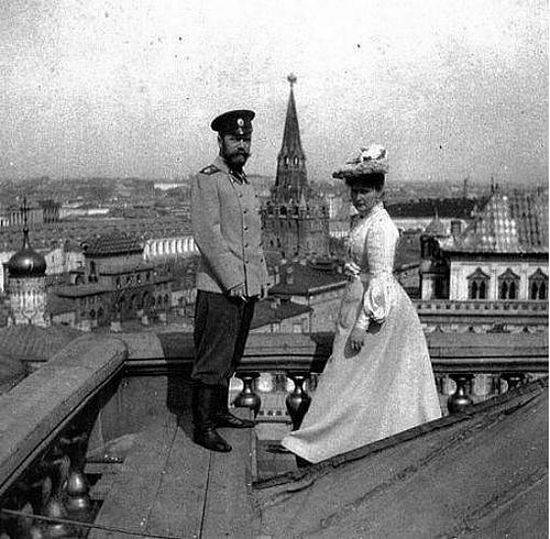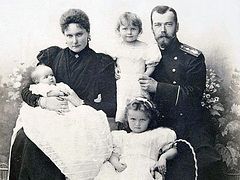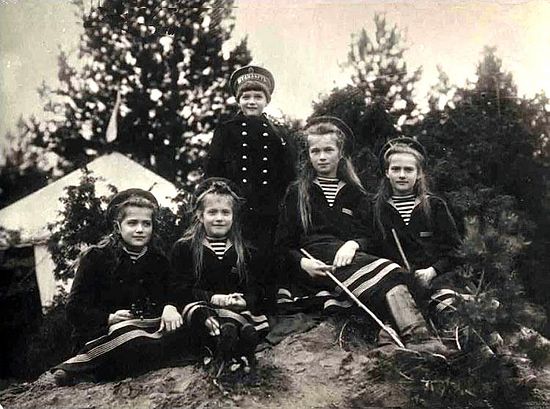 The Royal Child Martyrs.
The Royal Child Martyrs. The crown of Imperial Russia was one of the most resplendent in the world, shining with precious jewels and symbolizing a mighty nation that covered one-sixth of the globe. But in the beginning of our century, when the forces of evil arose to topple this mighty nation, the bastion of Orthodoxy, then even more resplendently shone the crown of Holy Russia, made of the purest gold of the New Martyrs and Confessors. And adorning this unique and magnificent crown were the most sparkling and wondrous jewels of all: the royal children-martyrs.
The Romanov children—the Grand Duchesses Olga, Tatina, Maria, Anastasia and the heir, Grand Duke Alexis—were extraordinary in their ordinariness. Despite being born in one of the highest and most enviable positions in the world (from the secular point of view), and having access to all possible worldly goods, they lived and were brought up like ordinary children. Even more amazingly, despite being surrounded by a court environment made up of the entirely secular, godless and apostate aristocracy, the children grew up to be pious god-fearing and endowed with all manner of Christian virtue. Their royal father ensured that their upbringing would be similar to his own: they were not to be treated like hothouse plants or fragile china, but were to be taught their lessons, learn their prayers, allowed to play, and even fight and be moderately naughty. Thus they were brought up like normal, healthy Russian children, in an atmosphere of discipline, orderliness and almost ascetic simplicity.
They also grew up in an atmosphere of extraordinary spiritual love. Their parents' marriage was truly blessed in heaven, and God granted the Imperial pair that rare gem of happiness on earth—an idyllic union, so that during the first ten years of their marriage they were blissfully happy, both in their union and in their family life, and all the children were born into this atmosphere of love and tenderness. Moreover, this exemplary and close-knit family was further enhanced by being a veritable home church. Both parents were deeply religious and represented the ideal of both aspects of Orthodoxy—by birth and through conversion.
Tsar Nicholas was, of course, born Orthodox, grew up in a strongly Orthodox atmosphere and had a nearly thousand-year-old heritage of Orthodoxy behind him. But this heritage blossomed in him so splendidly primarily because of his innate qualities: great piety, modesty, tenderness of soul, generosity, trustiness, love of all of God's creatures. And this was the heritage, both ancestral and personal, which he passed on to his children and which they, too, embodied so well.
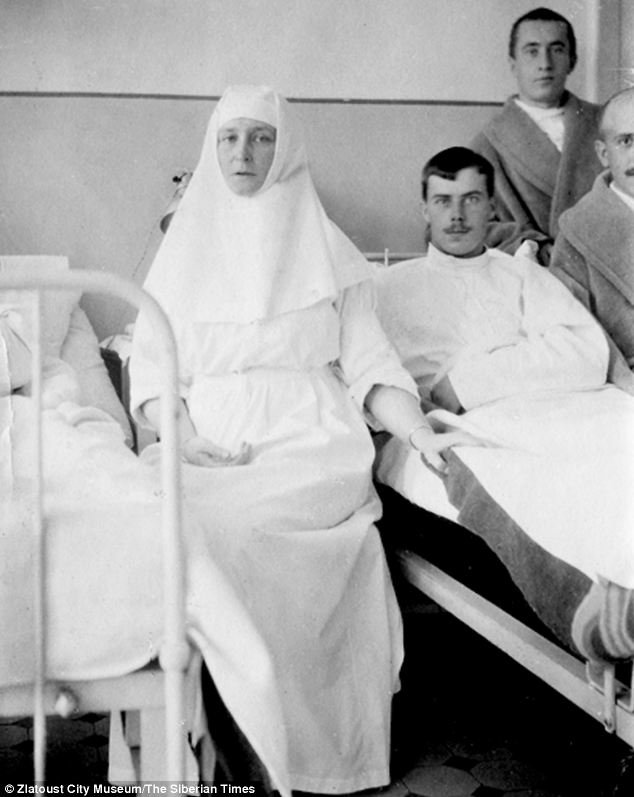 Tsarina Alexandra is seen on a hospital visit to injured servicemen.
Tsarina Alexandra is seen on a hospital visit to injured servicemen. The Empress Alexandra, though born Lutheran, grew up in a family that was also very religious. For this reason, and due to the sincerity and honesty with which she lived her faith, for a long time she could not agree to convert to another religion, even despite her great love for the Tsar. It was only after acquiring a deep understanding of Orthodoxy as the one true Faith that she was able to convert. However, when the Empress embraced Orthodoxy, she did so completely, with all the sincerity and honesty of her soul, so that she truly lived as an Orthodox Christian. It was this sincerity and honesty of faith which she passed on to her children and which was part of the fabric of their daily lives.
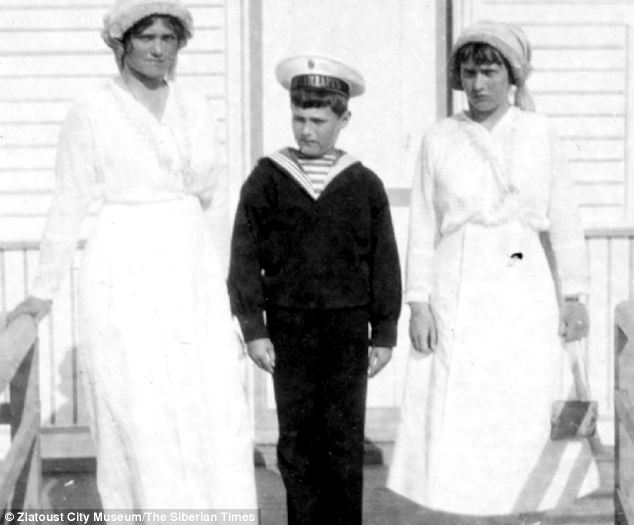 In this 1914 picture, four years before their execution, Nicholas's heir Alexei is seen with sisters Olga, left, and Tatiana, right.
In this 1914 picture, four years before their execution, Nicholas's heir Alexei is seen with sisters Olga, left, and Tatiana, right. The Romanov children were beautiful—not only in their outward appearance, which was striking, but primarily in their inner qualities. From their father they inherited the traits of kindness, modesty, simplicity, and unshakeable sense of duty and an all-consuming love for their homeland. From their mother they inherited deep faith, straightforwardness, self-discipline and strength of spirit. The Empress herself abhorred idleness and taught her children to be fruitfully engaged at all times. When World War I began, the Empress and her four daughters participated wholeheartedly in the war effort: they were literally tireless in visiting military hospitals and bringing cheer and comfort to the wounded soldiers, while the Empress and the two older daughters even qualified as Sisters of Mercy and performed the often anguishing tasks of surgical nurses. "The higher a person's position in society,'' the Tsar-Martyr used to say, "the more he should help others without ever reminding them of his position." Being himself a prime example of gentleness and attentiveness to the needs of others, the Tsar-Martyr brought up his children to be the same.
Within the framework of collective family qualities, the royal children were quite individual in character and temperament.
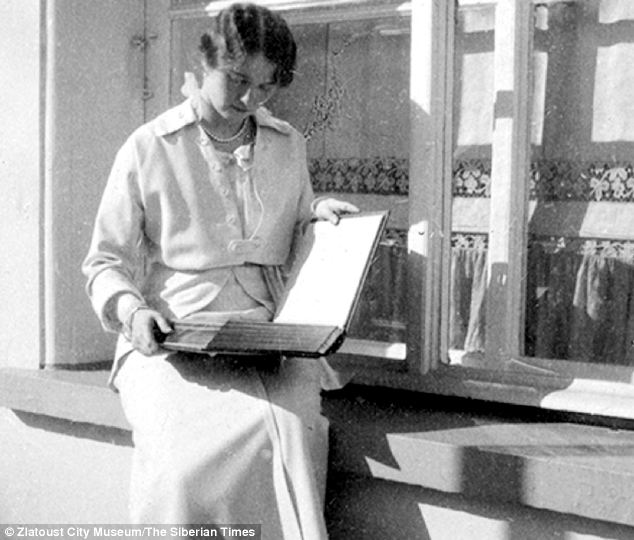 Grand Duchess Olga is seen looking through a family album.
Grand Duchess Olga is seen looking through a family album. Olga, the oldest daughter, born in 1895, was fair, with golden-brown hair (the lightest in the family) and beautiful blue eyes. She was innocent, modest, sincere and kind. She liked simplicity and paid little attention to dress. She was most similar to her father, whom she loved better than anyone else. She had a quick mind and possessed the virtue of reasoning. According to her tutors, she had a "crystal'' soul and a bright smile; inner joy radiated from her and had an uplifting effect on those around her. Like her father, Olga deeply loved Russia and the Russian people. When faced with the possibility of marriage to a foreign prince, she flatly refused, saying, "I do not want to ever leave Russia. I am Russian and wish to remain so." Thus she stayed on in her homeland to receive the crown of martyrdom.
<img align="center" alt="Tatiana in her garb as a sister of mercy surrounded by flowers as she reads." data-cke-saved-src="http://www.pravoslavie.ru/sas/image/101249/124930.p.jpg" src="http://www.pravoslavie.ru/sas/image/101249/124930.p.jpg" text-align:="" center;"="">
Tatiana, the second daughter, born in 1897, was a tall, thin and elegant girl. She had a darker complexion than the others. She was somewhat reserved, dutiful and pensive; she was often more decided in her opinions than her sisters. She was a talented pianist and also painted and embroidered well. Tatiana was her mother's favorite, having inherited the Empress' nobleness and sense of discipline. The younger children nicknamed Tatiana "the Governess."
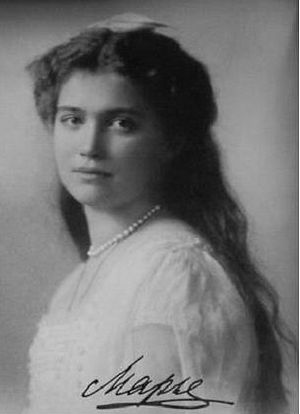 Grand Duchess Maria.
Grand Duchess Maria. 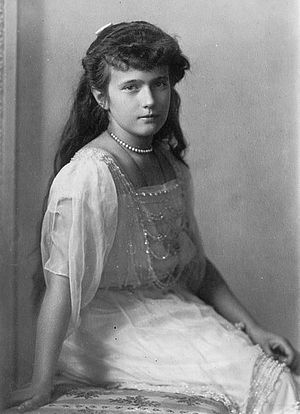 Grand Duchess Anastasia.
Grand Duchess Anastasia. Alexis, the heir apparent, was a very special child. He was born in 1904, in response to prayers offered by the Imperial family and the entire faithful populace during the days of glorification of Saint Seraphim of Sarov, asking God to grant Russia an heir. However, though born the heir lo the Russian Empire, Alexis could not inherit it, since Russia was already set on its apocalyptic course; instead, he inherited an incomparably higher kingdom—the Kingdom of Heaven.
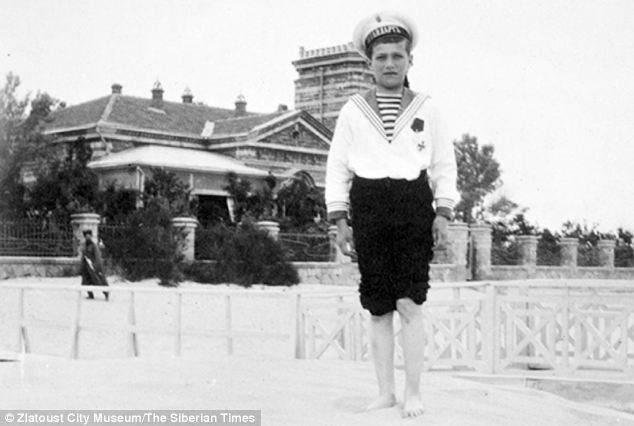 Tsarevitch Alexei, most likely in the Crimea.
Tsarevitch Alexei, most likely in the Crimea. Alexis was destined for martyrdom from the moment of his birth: the only and beloved son, he was the young Isaac who was actually sacrificed, the innocent sacrificial lamb who was worthy to atone for the sins of his people. He was born with the dreaded illness of hemophilia, which showed up when he was only six weeks old, and which caused him great pain and suffering for the entire 14 years of his brief life. It was also the cause of the greatest anguish for his family, especially his parents, and was a contributing factor to the fall of the Empire. And yet this young boy bore his terrible burden with great fortitude, silently and without grumbling, in a true Christian manner. At the same time he was like any other boy: he enjoyed games and horseplay, engaged in outdoor activities with other boys whenever possible, loved to go sailing with his father, teased his sisters, liked to watch movies, make boats and other paper models, and, though a very clever boy, was not fond of books. He had a kind heart, liked to give presents everyone, and he loved animals. He was a lively and cheerful child, a universal favorite, beloved by all with whom he came into contact. His mother loved him passionately, suffering a mother's indescribable anguish over his pains and his illness, which he had inherited from her side of the family.
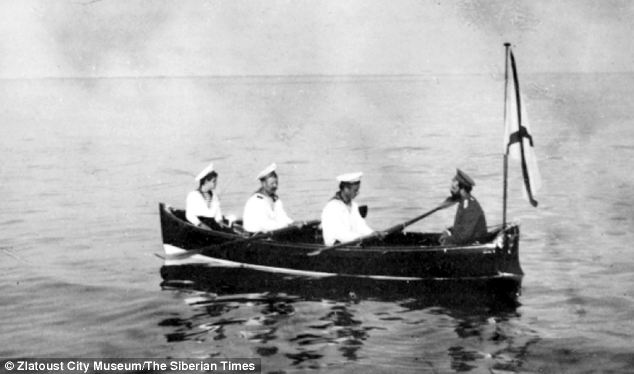 Tsar Nicholas II and Alexei on a boat in Finland.
Tsar Nicholas II and Alexei on a boat in Finland. God granted these extraordinary royal children a spiritually royal fate on earth: after having spent their childhood and youth in a most glorious Orthodox way of life, in absolute innocence and purity, they were ready for the crowning touch—the shining crown of martyrdom. Their Calvary began on March 2, 1917, the day of the Tsar-Martyr's abdication—first in their palace at Tsarskoye Selo, then at the Governor's house in Tobolsk, and finally, at the Ipatyev house—the "House of Special Purpose" -in Ekaterinburg, they suffered increasing stages of harassment, humiliation and deprivation. Their prison guards became progressively more insolent, heartless and brutal, subjecting them to insult, mockery and torment. The royal martyrs bore it all with great fortitude, strength of spirit, true Christian humility and total acceptance of the will of God. They sought solace in church services, home prayers and spiritual reading. They were heinously murdered, these pure and innocent children, in the night of July 4, 1918, and from the blood-soaked cellar in Ekaterinburg they passed triumphantly into the royal palace of the King of Heaven.
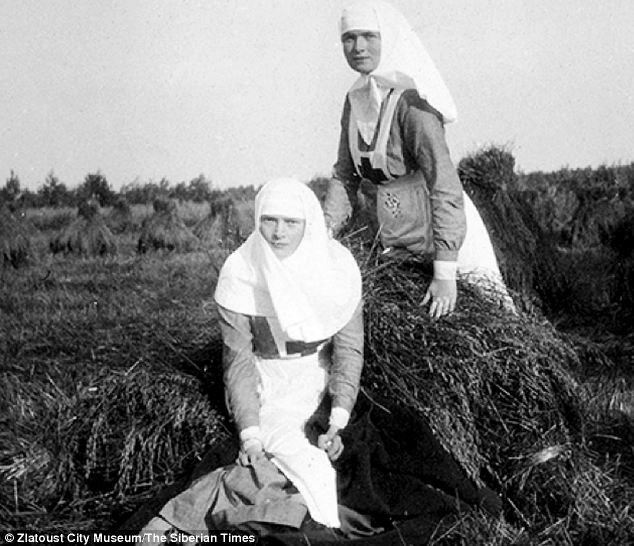 The grand duchesses Olga and Tatiana as sisters of mercy, at the hay-cutting. Pprivate family photo taken in 1916..
The grand duchesses Olga and Tatiana as sisters of mercy, at the hay-cutting. Pprivate family photo taken in 1916.. Almost a century separates us from these holy children-martyrs, and yet they are very close to us, very real to us, for we, the last Christians, have much in common with them. They lived at the threshold of the godless Communist rule—that seventh apocalyptic "king" of Revelation, who would "continue for a short space," while we live at the threshold of the coming of Antichrist -the beast who is the eighth (Rev. 17:10-11). They were surrounded by a godless, totally apostate society, while we live in a godless, totally apostate world. And yet, they serve as a shining example to us, Orthodox children and parents who strive to raise Orthodox children in a pagan world, that with the help of God and through the intercession of His righteous ones, it is still possible to live a truly Christian life and raise a truly Christian family, even in our most evil modern times.
O holy Royal Martyrs Nicholas, Alexandra, Alexis, Olga, Tabana, Maria and Anastasia, pray to God for us, that we, too, when the hour of trial comes upon us, remain faithful to our Lord Jesus Christi Amen.
Text from: Orthodox America

